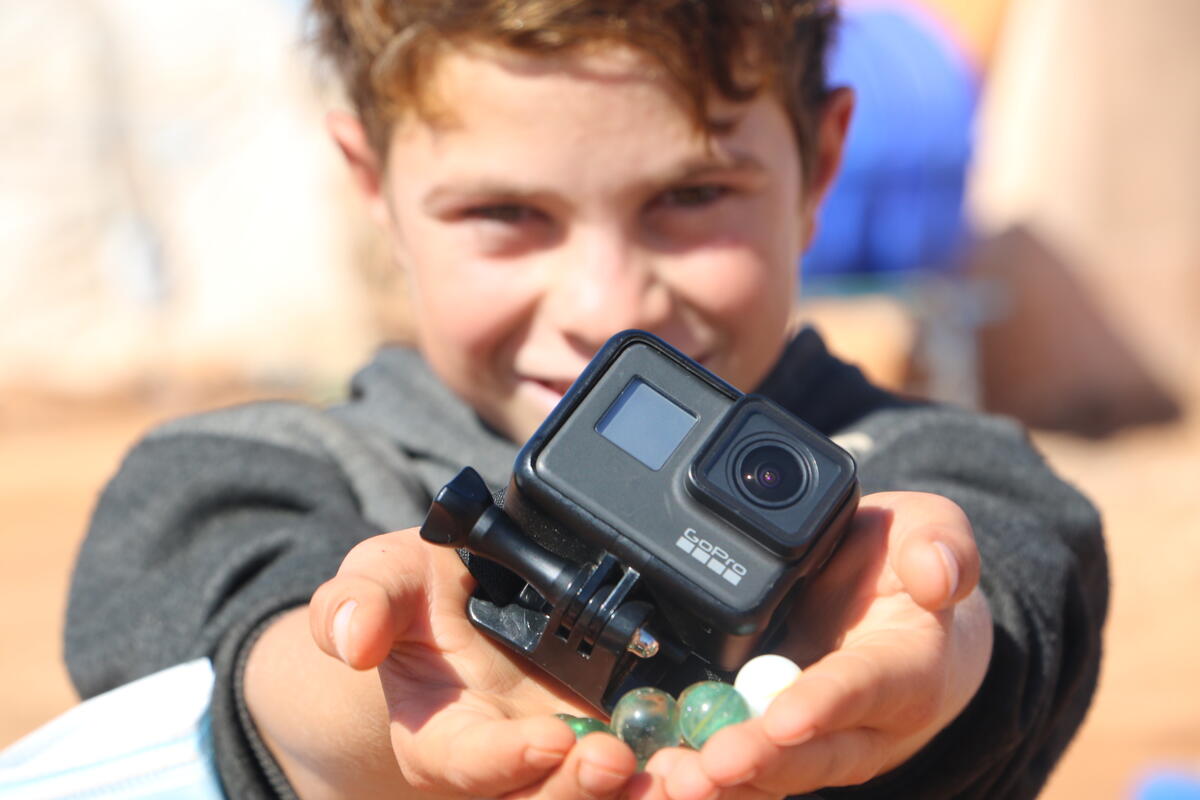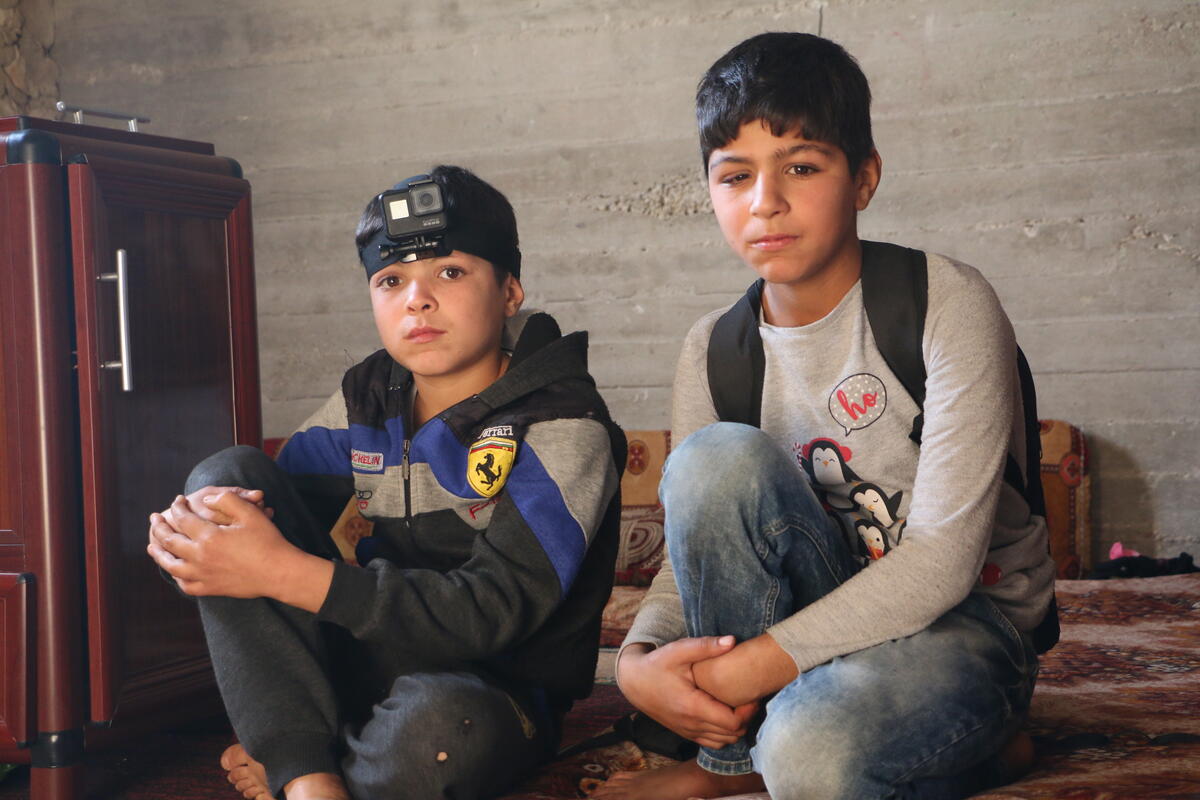


Layla*, 11 at school. Samir*, 11 holding the GoPro camera. Siblings Yousef*, 12 and Adam* 11 at home in Idlib, north west Syria. Credit line: Hurras Network/ Save the Children
After 11 years of conflict, children across Syria remain in catastrophic conditions, living in unsanitary, unsafe camps, exposed to shelling and airstrikes, and facing hunger, illness and malnutrition, Save the Children said today.
Conflict across Northern Syria is still causing civilian casualties and forcing families from their homes, Save the Children said. In 2021, Save the Children and its partner organisation, Hurras Network, documented 15 attacks on schools across North West Syria. In October, three children and a teacher were killed in an attack on their way to school.
Across the country, 6.5 million children need humanitarian assistance, 2.5 million children are out of school and close to 800,000 children are malnourished.
The country is also in the midst of an economic crisis, with the COVID-19 pandemic, devaluation of key currancies, and shortages in basic goods contributing to financial struggles for families across Northern Syria.
The price of an average food basket increased by 97% from December 2020 to December 2021, meaning that by the end of the year, the average household spent 41% of its income on food to ensure their family’s survival. Around 12 million people, 55% of the population, are food insecure.
Families are significantly reducing the amount of food they eat and most depend entirely on humanitarian assistance. Some have resorted to negative coping mechanisms such as child labour, which the UN says is prevalent in 22% of communities across Syria.
As the Ukraine crisis leads to what UNHCR calls the fastest-growing number of refugees in Europe since the Second World War, those who have fled from Syria should not be forgotten, and states should protect and uphold the rights of all refugees, Save the Children added.
12-year-old Yousef*, who lives in Ma’arat Misrin in Idlib, North West Syria, lost both of his parents in separate shelling attacks. The first attack, which killed his mother, also caused permanent injuries to his legs. He ended up fleeing his home with his siblings nine years ago.
Yousef said: “We’ve been living in my grandfather’s house for the past three years but because of violence and financial issues, the building isn’t finished yet. Both of my parents are dead. My mother has been dead for nine years and my father for three. I have injuries to my legs because a shell fell on us when we were sitting at home. My father used to take me to the hospital [for medical treatment for my legs] but now there’s no one left to take me. I always want to play and run but I cannot.”
13-year-old Ahmed* is the eldest of 10 children and lives in a displacement camp in rural Idlib. He works in a shop after school to help pay for food for his siblings, as their father passed away three years ago from illness. He said: ‘Since I am the eldest and no one is there to help, I work here, so we can live.’ He says that most people borrow food from the shop “until they work and make money to repay their debts. May God help people.”
In North East Syria, communities are grappling with an escalating water crisis due to drought, low levels of water in key rivers, and lack of access to damaged water station infrastructure, Save the Children said.
Khazna*, a 26-year-old mother of a one-year-old baby, living in Shedadeh, a town by the Euphrates River, told Save the Children: “The environment which I live in is not a clean one. Dirt and insects get into our food. We do not have refrigerators to preserve our food. Our clothes become dirty and my child gets allergies due to that. My son and I often have diarrheoa and stomach aches. Because of all of that, I was losing weight and getting thinner by day. Dark circles started to appear under my eyes. I had anaemia too.”
Because of the lack of clean running water, many mothers are going without food to prioritise spending money on drinking water.. In a recent study carried out by Save the Children across five communities in North East Syria, nearly a third (30%) of breastfeeding women said that they could not produce enough breast milk for their babies, and when they could it was often poor quality. The same study found that 7% of children between 6-59 months had severe acute malnutrition, and 13% had moderate acute malnutrition.
Save the Children’s Syria Response Director, Sonia Khush, said: “Eleven years after the start of the conflict, Syria is still not a safe place for children.
“Living through this kind of violence, grief and loss, and being uprooted in some cases several times, as well as a lack of opportunity to build a better future, has had a profound impact on children’s mental health and wellbeing. Children need to live in peace. All children in Syria deserve a future.
“As the world’s attention turns to violence in Ukraine, we cannot let Syria’s children be forgotten. Eleven years of conflict is an outrage. All parties to the conflict need to end the violence to ensure a safe environment for children. The international community needs to increase funding and the delivery of the lifesaving supplies and services that are essential for all children to survive, be protected from harm and to thrive. Refugees who have fled Syria need to be protected, as is the obligation of states under international law.”
Save the Children has been working in Syria since 2012, reaching over five million beneficiaries, including more than three million children across the country. Save the Children’s programming combines emergency & life-saving interventions with early recovery activities that support the restoration of basic services, including child protection, education, emergency response, food security and livelihoods, water sanitation and hygiene as well as health and nutrition.
*names have been changed for safety reasons
